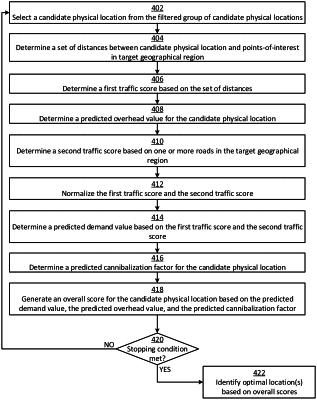| CPC H04L 41/145 (2013.01) [H04L 41/147 (2013.01); H04L 41/22 (2013.01)] | 20 Claims |

|
1. A non-transitory computer-readable medium comprising program code that is executable by one or more processors for causing the one or more processors to:
execute an iterative optimization routine configured to evaluate a group of candidate physical locations to determine one or more optimal locations at which to deploy one or more objects in a target geographical region, wherein each iteration in the iterative optimization routine involves:
selecting a candidate physical location from the group of candidate physical locations;
executing a trained demand model configured to output a predicted demand value for the candidate physical location based on a first traffic score and a second traffic score associated with the candidate physical location;
executing one or more trained overhead models configured to output a plurality of predicted overhead values for the candidate physical location;
determining a predicted cannibalization factor associated with the candidate physical location; and
generating an overall score for the candidate physical location based on the predicted demand value, the plurality of predicted overhead values, and the predicted cannibalization factor;
determine the one or more optimal locations based on the overall score associated with each candidate physical location; and
generate a graphical user interface that includes a visual map having graphical elements identifying the one or more optimal locations.
|